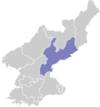
Onsŏng County is a county (kun) in North Hamgyong Province, North Korea, located near the border with China. The administrative center is the town (ŭp) of Onsong. Onsong is the alleged site of the former Onsong concentration camp, now closed.

Musan County is a county in central North Hamgyong province, North Korea. It borders the People's Republic of China to the north, across the Tumen River. It is divided into one ŭp, six labor districts, and fifteen ri. The county seat is the town of Musan, Musan ŭp. Luguo and Dehua are the closest Chinese cities across the river.

Ŏrang County is a kun, or county, in North Hamgyŏng province, North Korea. It is situated on the coast of the Sea of Japan. Originally part of Kyŏngsŏng county, Ŏrang was created in 1952 following the division of Korea.

Yŏnsa County is a kun, or county, in North Hamgyŏng province, North Korea. It was created following the division of Korea, being split off from Musan county in the 1952 reorganization of local government.
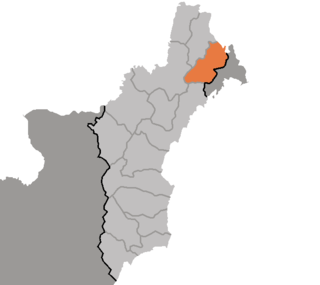
Kyŏnghŭng County is a kun, or county, in North Hamgyong province, North Korea. Formerly known as Ŭndŏk County, from 1977 to 2010.

Kyŏngwŏn County is a kun, or county, in North Hamgyong province, North Korea, located at 42°48′41″N130°11′58″E, formerly known as Saebyŏl. It is bordered by the People's Republic of China to the north and east, Kyonghung to the southeast, Hoeryong to the southwest, and Onsong to the west.

Puryŏng County is a kun, or county, in North Hamgyŏng province, North Korea.

Chŏngp'yŏng County is a county in South Hamgyŏng province, North Korea. It borders South P'yŏngan province to the south, and the East Korea Bay to the east.
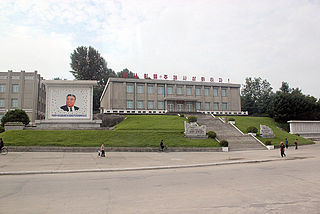
Kŭmya County is a county in South Hamgyŏng province, North Korea. It borders the Sea of Japan to the east.

Changjin County is a mountainous county in South Hamgyong Province, North Korea.
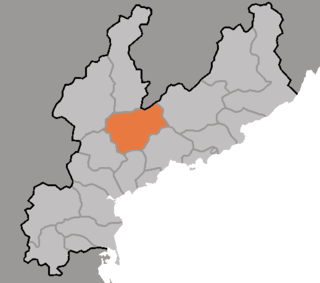
Sinhŭng County is a mountainous county in South Hamgyŏng province, North Korea.

Hongwŏn County is a county in South Hamgyŏng province, North Korea. It is flanked by the Sea of Japan to the south, and by the Hamgyŏng Mountains to the north.

Riwŏn or Iwon County is a county in South Hamgyŏng province, North Korea. It is located at the province's northeastern tip and borders the Sea of Japan to the southeast.
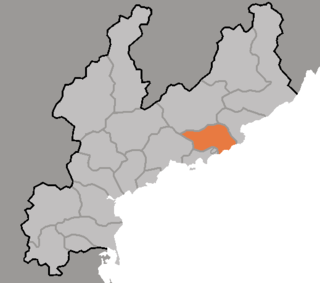
Pukch'ŏng County is a county in eastern South Hamgyŏng province, North Korea.

Kimhwa County is a kun, or county, in Kangwŏn province, North Korea.

Kimhyŏnggwŏn County is a kun, or county, in southeastern Ryanggang province, North Korea. It borders South Hamgyŏng to the south. Previously known as Pungsan, it was renamed by Kim Il Sung in 1990. He named it after his uncle, Kim Hyŏng-gwŏn. It is known for its striking scenery and for the Pungsan Dog, a large breed of hunting dog.
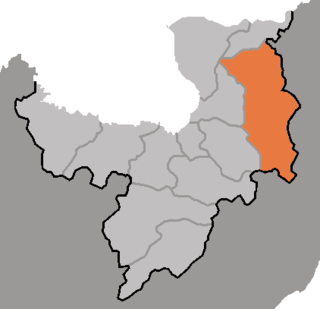
Paegam County is a kun, or county, in Ryanggang province, North Korea.

P'ungsŏ County is a kun, or county, in Ryanggang province, North Korea. It was formed after the division of Korea from portions of Kimhyŏnggwŏn and Kapsan counties.

Rangrim County is a kun, or county, on the eastern flank of Chagang province, North Korea. It was created in 1952 from portions of Changgang and Changjin, as part of a general reorganization of local government. Originally part of South Hamgyong, it was transferred to Chagang province in 1954. It borders Hwapyong and Ryanggang's Kimjongsuk and Kimhyongjik counties to the north, South Hamgyong's Pujon county to the east and Changjin to the south, as well as the counties of Changgang, Songgan, and Ryongnim to the west.
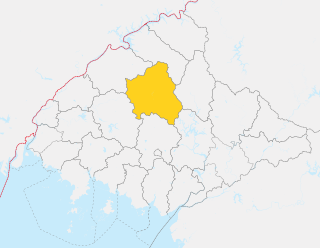
Taegwan County is a kun, or county, in northeastern North P'yŏngan province, North Korea. It lies in the province's interior, and is bounded by Tongch'ang on the east, Kusŏng and T'aech'ŏn to the south, Ch'ŏnma to the west, and Ch'angsŏng and Sakchu to the north. It was created in 1952 from portions of Sakchu county.





















